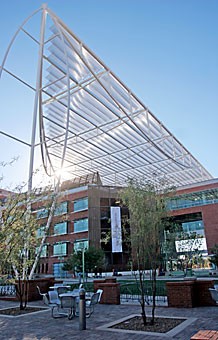The BIO5 Institute and the UA College of Medicine will celebrate the official opening of the conjoined Thomas W. Keating Bioresearch building and the Medical Research building today.
The BIO5 Institute, which represents five fields of study – agriculture, medicine, pharmacy, basic science and engineering – together with the College of Medicine will dedicate the new buildings today during the Open Doors, Open Minds celebration.
The building is especially important to the university because it will bring together undergraduates, graduates and post-doctoral students, along with faculty and research technicians from 13 different departments, said Vicki Chandler, director of BIO5.
“”It’s a red-letter day to have a building dedicated to interdisciplinary research,”” said Michael F. Hammer, an associate professor and research scientist at the BIO5 Institute.
The BIO5 building will be occupied by 350 researchers, 40 percent of them undergraduates and graduate students and the other 60 percent faculty, research technicians and post-doctoral students, Chandler said.
“”Most universities operate with separate buildings housing the different departments, but with having resources in the same building, it allows for the cross-fertilization of ideas,”” Hammer said.
The Medical Research building next door is projected to have two-thirds of the building filled with non-faculty working on projects, including 100 undergraduates, 80 graduate students and 60 post-doctoral students, said Katie Maass, senior program co-coordinator of public affairs in the College of Medicine.
“”There are many opportunities for the students to collaborate with other researchers,”” she said.
The BIO5 and medical buildings will not only cater to researchers and biology students, but will also facilitate collaboration with business, law, and social and behavioral science students, Chandler said.
“”To translate findings to real-world applications, we need to have marketing accessibility studies done, and we also have patent laws to deal with,”” Chandler said.
The new building focuses heavily on interdisciplinary research and its structure allows ease of communication between different combinations of disciplines, said Thomas Davis, a professor of pharmacology in the BIO5 Institute.
“”It is an excellent idea, a novel idea for the university to reach out among the various disciplines to work in a collaborative manner,”” Davis said.
Construction of the Thomas W. Keating building began in October 2003 with a projected budget of $65,652,000. The Medical Research building began construction in June 2004 and was projected to cost $54,350,000, according to Facilities Design and Construction.
Although construction costs were high, the building should pay for itself by bringing in high-profile professors and researchers from across the nation, Chandler said.
“”It is well-documented across the nation and the world that top research universities are powerful engines for generating research results that can lead to commercialization,”” Chandler said.
Collaborating researchers tend to also write new research grants that turn into federal dollars from the government, Chandler said.
The biosciences community is taking notice of the opening of the BIO5 and Medical Research buildings.
“”It’s one of the critical pieces that will help Arizona achieve becoming a biosciences leader, along with the UA and (Arizona State University) medical buildings in Phoenix,”” said Steven Lynn, vice chair of Arizona’s Bioscience Roadmap Steering Committee.
The UA is a leader in bioscience research, making up 59 percent of all university life sciences research in Arizona, according to a Battelle Science and Technology International study written for the Southern Arizona Leadership Council. The UA has also advanced in university research growth by 60 percent compared with 37 percent growth nationally.
Some of the projects that BIO5 is working on are smart drugs that can target cancer cells, a drug to cure valley fever and research for regenerating tissue, organs and joints, Chandler said.
The Medical Research building is also looking into new ways to cure human ailments, with each floor in the building devoted to a certain disease, Maass said.
“”We have floors devoted to cancer research, heart disease, diabetes, neuroscience, epilepsy and stroke,”” Maass said.









